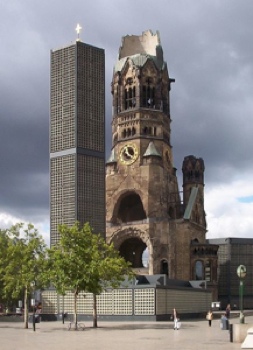Summary | Excerpt | Reading Guide | Reviews | Beyond the Book | Read-Alikes | Genres & Themes | Author Bio

Critics' Opinion:
Readers' Opinion:
First Published:
Aug 2012, 400 pages
Paperback:
May 2013, 448 pages
 Book Reviewed by:
Book Reviewed by:
Kim Kovacs
Buy This Book
This article relates to City of Women
Berlin, Germany's capital city, was home to more than four million citizens at the start of WWII.
Between 1940 and 1945, the city was the target of 363 air raids, with an estimated 20,000 civilians killed during the period. The most significant and organized series of raids occurred from November 1943 to March 1944.
 The controversial mission was led by Sir Arthur "Bomber" Harris, the Commander-in-Chief of Britain's Bomber Command, the branch of the Royal Air Force (RAF) that controlled Britain's bomber forces. Harris felt that a concerted air attack against the German capital would break the morale of its citizens and cause Germany to capitulate. "It will cost us between 400 and 500 aircraft," he is reported to have said, "but it will cost Germany the war."
The controversial mission was led by Sir Arthur "Bomber" Harris, the Commander-in-Chief of Britain's Bomber Command, the branch of the Royal Air Force (RAF) that controlled Britain's bomber forces. Harris felt that a concerted air attack against the German capital would break the morale of its citizens and cause Germany to capitulate. "It will cost us between 400 and 500 aircraft," he is reported to have said, "but it will cost Germany the war."
The first concerted attack occurred on the night of November 18-19, 1943, when Britain launched 440 Lancaster aircrafts to bomb Berlin. It was cloudy, however, so what bombing occurred happened blindly, and Bomber Command was unable to make an assessment of the result.
The next raid on November 22-23 was the most successful of the war. The weather kept most of the German fighter force on the ground while 764 RAF planes bombed the central core of the city westward into the residential districts of Tiergarten and Charlottenburg. Several firestorms were reported, and a smoke cloud rising 6,000 meters (nearly 19,000 feet) into the air was seen the following day. It is estimated that 2,000 Berliners were killed and 175,000 people were bombed out by this single operation. Damaged or destroyed structures included the Kaiser Wilhelm Memorial Church, the Charlottenburg Castle, the Berlin Zoo, the British, French, Italian and Japanese embassies, the Ministry of Weapons and Munitions, the Waffen SS Administrative College, the barracks of the Imperial Guard at Spandau and, among many industrial sites, five factories of the Siemens electrical group and the Alkett tank works. The RAF experienced minimal loss in this raid, with only 26 aircraft downed by enemy forces (3.4%).
 Ultimately 16 attacks were made during the Bombing of Berlin against both strategic and civilian targets. It's estimated that 4,000 citizens were killed, 10,000 injured and nearly half a million made homeless.
Ultimately 16 attacks were made during the Bombing of Berlin against both strategic and civilian targets. It's estimated that 4,000 citizens were killed, 10,000 injured and nearly half a million made homeless.
In spite of the massive destruction inflicted on the city, the bombing did not have the impact that was intended and the mission is generally considered a failure. First, although British losses were relatively low at first, they rose dramatically over subsequent sorties. During the course of the campaign the RAF lost more than 500 aircraft; 2,690 crewmen were killed and approximately 1,000 captured and sent to POW camps.
Secondly, the Berliners didn't capitulate as the proponents of the bombing had expected (just as the citizens of London did not, even after 57 nights of continuous bombing during Germany's Blitz of British cities earlier in the war). There were a number of reasons that Berlin didn't fall. To begin with, the Germans had learned lessons from the total devastation of Hamburg in July 1943, where over 30,000 were killed in a single Allied air raid, and consequently had a better idea of how to defend Berlin. It was heavily fortified with searchlights and anti-aircraft guns, and decoy fires and marker flares were deployed to confuse the RAF navigators. The residents also prepared by readying bomb shelters, including rigging the U-Bahn (subway) system to accommodate a large number of people for an extended period of time. The city's design also played a huge part in keeping fires contained. Many buildings were constructed of stone, not wood, and didn't ignite as easily; roofs were often sloped, so frequently incendiaries slid off them down into the street; and Berlin's wide avenues acted as a firebreak and were less cluttered with debris, permitting emergency crews to reach stricken areas more quickly. All in all, Britain was unable to break German civilian morale, and essential services were uninterrupted even as conditions worsened throughout the war.
To take a tour of Berlin after the war, click on the video below:
Pictures from Wikipedia.com
Filed under People, Eras & Events
![]() This "beyond the book article" relates to City of Women. It originally ran in September 2012 and has been updated for the
May 2013 paperback edition.
Go to magazine.
This "beyond the book article" relates to City of Women. It originally ran in September 2012 and has been updated for the
May 2013 paperback edition.
Go to magazine.





The House on Biscayne Bay
by Chanel Cleeton
As death stalks a gothic mansion in Miami, the lives of two women intertwine as the past and present collide.

The Flower Sisters
by Michelle Collins Anderson
From the new Fannie Flagg of the Ozarks, a richly-woven story of family, forgiveness, and reinvention.

The Funeral Cryer by Wenyan Lu
Debut novelist Wenyan Lu brings us this witty yet profound story about one woman's midlife reawakening in contemporary rural China.
Your guide toexceptional books
BookBrowse seeks out and recommends the best in contemporary fiction and nonfiction—books that not only engage and entertain but also deepen our understanding of ourselves and the world around us.